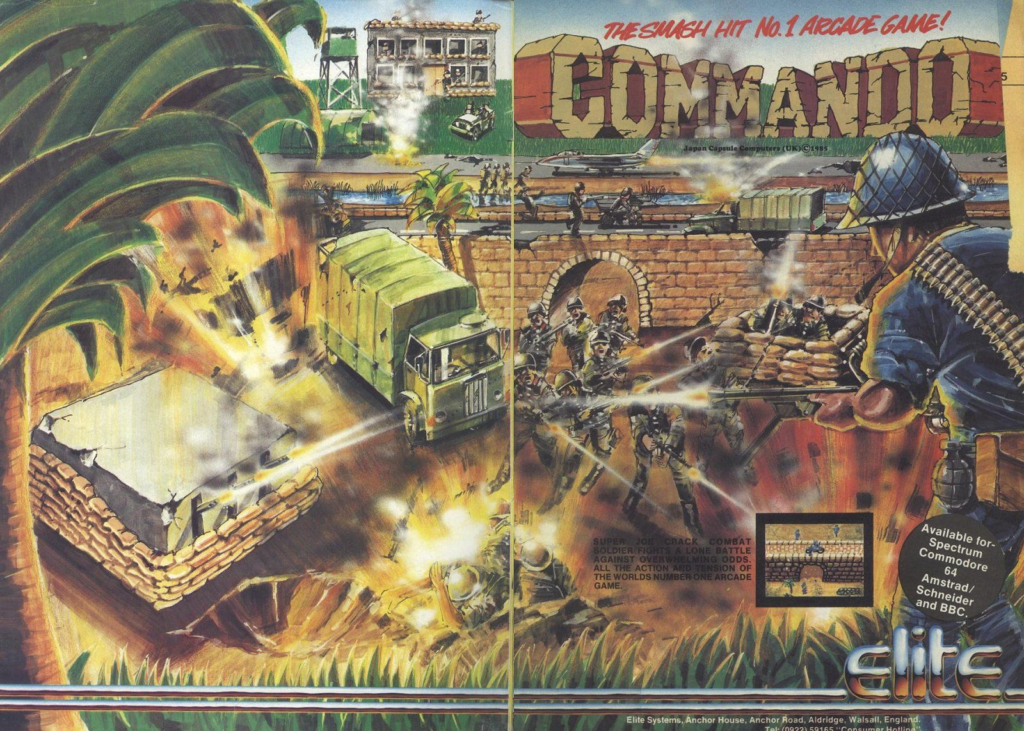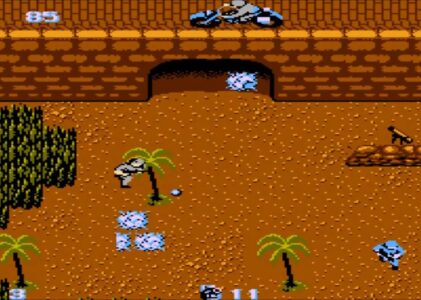In the vibrant landscape of arcade gaming history, few titles have left as indelible a mark as “Commando.” Bursting onto the scene in the 1980s, this high-octane shooter game forever altered the course of gaming, carving its legacy into the hearts of players worldwide. In this comprehensive exploration, we’ll dive into the depths of “Commando,” uncovering its genre, gameplay mechanics, key features, strategies, reviews, cultural impact, sequels, and similar games. Let’s embark on a journey through the thrilling world of “Commando.”
The Birth of a Genre: Arcade Action Unleashed
In the mid-1980s, the arcade scene was a cacophony of flashing lights, cacophonous sounds, and the electric buzz of excitement. Arcade machines stood as vibrant portals to other worlds, where players could embark on adventures, test their skills, and, most importantly, empty their pockets of quarters. Amid this bustling landscape, “Commando” made its debut, heralding a new era of arcade action.
Arcade Gaming in the 1980s: A Golden Age
To understand the significance of “Commando,” we must first step back into the arcade gaming landscape of the 1980s. It was a golden age where innovation ran rampant. Games like “Pac-Man,” “Donkey Kong,” and “Space Invaders” had already left an indelible mark on the industry, captivating players with their unique gameplay mechanics and colorful graphics.
Arcades themselves were vibrant and social places. Neon lights adorned the walls, rows of cabinets filled the floor, and the air was thick with the scent of popcorn and the sounds of clinking coins. It was a time when a single game could capture the collective imagination of a generation, and “Commando” was poised to do just that.
Capcom: A Rising Star
In the early 1980s, a Japanese game developer named Capcom was steadily gaining recognition in the arcade industry. Founded in 1983, Capcom had already released notable titles like “1942” and “Ghosts ‘n Goblins.” These games showcased Capcom’s commitment to pushing the boundaries of what arcade games could achieve in terms of graphics, gameplay, and innovation.
Enter “Commando”: A Vertical Scrolling Marvel
“Commando” was born from this creative crucible. When it was unleashed into arcades in 1985, it took the gaming world by storm. The game’s genre, a top-down vertically scrolling shooter, was not entirely new, but “Commando” executed it with an unmatched level of finesse and intensity.
The game’s premise was simple yet compelling: Players assumed the role of Super Joe, a one-man army tasked with infiltrating enemy lines and rescuing hostages. The game’s vertical scrolling mechanism was groundbreaking. It allowed players to ascend the battlefield, giving a dynamic sense of progression and a tactical advantage over the enemy forces.
The Awe of Cutting-Edge Graphics
One of “Commando’s” standout features was its graphics. In an era where pixel art reigned supreme, “Commando” delivered detailed character sprites, lush jungle environments, and impressive explosions. The game’s visuals transported players to a war-torn landscape, immersing them in the chaos and intensity of battle.
The Evolution of Gameplay
“Commando” also introduced a groundbreaking control scheme. It utilized an eight-way joystick for movement and a single button for shooting. This simplicity in controls allowed players to focus on the action without the distractions of complex inputs. It was easy to pick up and play, yet challenging to master, making it accessible to a wide range of gamers.
Quarters Disappeared Rapidly
As players ventured into the virtual battlefield, they found themselves facing relentless waves of enemy soldiers, tanks, and helicopters. “Commando” was infamous for its challenging difficulty, and it had an uncanny ability to devour quarters at an astonishing rate. Players became addicted to the exhilaration of inching closer to victory, one hard-fought inch at a time.
The Social Aspect of Arcade Play
“Commando” also tapped into the social aspect of arcade gaming. Crowds would gather around the machine, watching in awe as skilled players weaved through enemy fire, rescued hostages, and unleashed devastating attacks. The game’s competitive nature fueled a sense of camaraderie among arcade-goers, as they shared strategies and celebrated each other’s achievements.
The “Commando” Legacy Begins
With “Commando,” Capcom not only established itself as a formidable player in the arcade industry but also laid the foundation for a gaming legacy that would endure for decades. The game’s success in arcades paved the way for its expansion to home gaming platforms, ensuring that the legend of Super Joe would live on.
In the subsequent years, “Commando” would inspire sequels, reimaginings, and a dedicated fanbase that continues to cherish its timeless gameplay. The impact of this explosive arcade masterpiece reached far beyond the confines of the arcade cabinet, embedding itself in the cultural tapestry of gaming history.
Platforms and Widespread Accessibility
Following its arcade success, “Commando” found its way onto numerous home gaming platforms, expanding its reach and cementing its place in gaming history. The game was ported to popular systems of the era, including the Commodore 64, Atari 2600, NES (Nintendo Entertainment System), and ZX Spectrum. This widespread accessibility ensured that gamers of all backgrounds could experience the adrenaline-pumping action of “Commando” from the comfort of their own homes.

Gameplay: The Heat of Battle
“Commando” thrusts players into the role of a highly skilled commando named Super Joe. Tasked with infiltrating enemy lines and rescuing hostages, the game combines intense combat with strategic maneuvering. Here’s a closer look at the core gameplay mechanics:
1. Vertical Scrolling Action: The game features a top-down perspective with vertically scrolling screens. Players must navigate through dense jungles, enemy camps, and fortresses, shooting down hordes of enemy soldiers and vehicles.
2. Weapons Arsenal: Super Joe is armed with a default submachine gun, but players can pick up a variety of power-ups and weapons throughout the game, including grenades, rocket launchers, and even a flamethrower. Each weapon offers a unique advantage in different situations.
3. Strategic Movement: “Commando” challenges players to use cover, dodge enemy fire, and strategically position themselves to survive the relentless onslaught of adversaries. The ability to throw grenades adds an extra layer of tactical depth to the gameplay.
4. Hostage Rescue: The primary objective is to rescue hostages scattered across the levels. Players must approach each hostage carefully while fending off enemy forces. Successful rescues provide additional points and power-ups.
5. Challenging Enemies: “Commando” is renowned for its challenging AI, with enemies that swarm and attack relentlessly. Players must employ sharp reflexes and precise aiming to survive.
6. Multi-Level Mayhem: The game consists of multiple levels, each with its unique terrain, obstacles, and enemies. The difficulty escalates as players progress, ensuring a constant test of skill.
Key Gameplay Features: The Heart of the Action
1. Non-Stop Action: “Commando” delivers an unrelenting adrenaline rush. The action rarely lets up, keeping players on the edge of their seats from the first bullet fired to the last enemy defeated.
2. Weapon Variety: The diverse arsenal of weapons adds depth to the gameplay, encouraging players to adapt their strategy based on their current loadout. The choice of when to use grenades or unleash heavy firepower is crucial for success.
3. Precision Shooting: Aiming accuracy is paramount in “Commando.” Players must hone their shooting skills to take down fast-moving enemies and avoid getting overwhelmed.
4. Intuitive Controls: The game’s controls are straightforward and intuitive, allowing players to focus on the action rather than struggling with complicated inputs.
5. High Score Competition: “Commando” fosters a spirit of competition among players, as they vie for high scores and bragging rights. Achieving the top spot on the leaderboard becomes an irresistible challenge.

Strategies for Survival: Mastering the Battlefield
As players delve into the heart-pounding world of “Commando,” a few strategies can significantly improve their chances of success:
1. Cover and Conquer: Effective use of cover is essential. Super Joe can hide behind rocks, trees, and walls to minimize exposure to enemy fire. Use these natural barriers to your advantage.
2. Ammo Management: Pay attention to your ammunition count. Running out of bullets in the heat of battle can be fatal. Collect weapon power-ups whenever possible to ensure a steady supply.
3. Hostage Prioritization: Rescuing hostages not only boosts your score but also provides valuable power-ups. Make it a priority, but do so cautiously, as enemies often lurk nearby.
4. Grenade Tactics: Mastering grenade throws can turn the tide of a battle. Use them to clear out groups of enemies, especially when you’re cornered.
5. Patience and Practice: “Commando” is a game that rewards patience and practice. Don’t rush headlong into danger. Take your time to aim accurately and learn the enemy patterns on each level.
Reviews and Cultural Impact: Explosive Reception
“Commando” exploded onto the gaming scene with rave reviews and quickly became a cultural phenomenon. Here’s a look at its reception and influence:
Critical Acclaim: Critics and gamers alike praised “Commando” for its exhilarating gameplay, challenging difficulty, and addictive qualities. Its success in arcades and on home consoles solidified its reputation as a must-play title.
Iconic Soundtrack: The game’s memorable music, composed by Tamayo Kawamoto, added to its charm. The catchy tunes continue to resonate with fans and are often remixed and featured in gaming soundtracks.
Pop Culture References: “Commando” made its mark on pop culture, inspiring references in movies, TV shows, and other forms of entertainment. It became synonymous with the action-packed spirit of the ’80s.
Legacy and Influence: “Commando” laid the foundation for the run-and-gun genre, influencing later classics like “Metal Slug” and “Contra.” Its impact can still be seen in modern gaming, where challenging shooters remain popular.
Sequels and Expanding the Franchise
The success of “Commando” paved the way for several sequels and spin-offs, each building upon the core gameplay and expanding the lore of the franchise. Notable entries include:
1. “Mercs” (1990): This sequel maintained the top-down shooter perspective but introduced a cooperative multiplayer mode, allowing players to team up with a friend to tackle the action-packed levels.
2. “Wolf of the Battlefield: Commando 3” (2008): A digital download release for modern consoles, this title stayed true to the series’ roots while adding updated graphics and online multiplayer.
3. “Commando: Steel Disaster” (2008): Released on the Nintendo DS, this entry brought the series to a handheld platform, adapting the gameplay for the dual screens and touch controls.
Similar Games: Exploring the Action-Packed Genre
“Commando” may be a pioneer in the run-and-gun genre, but it’s far from the only standout title. Here are a few notable games that share the same heart-pounding action:
1. “Contra” Series: “Contra” is a legendary run-and-gun franchise that challenges players with intense side-scrolling action and iconic boss battles. It’s often mentioned in the same breath as “Commando.”
2. “Metal Slug” Series: Known for its vivid, hand-drawn visuals and over-the-top weaponry, “Metal Slug” is another celebrated run-and-gun series that captured the hearts of gamers with its charismatic characters and challenging gameplay.
3. “Ikari Warriors” Series: This series shares the same top-down perspective and military theme, offering cooperative play and a similar action-packed experience.
4. “Gunstar Heroes” (1993): A Sega Genesis classic, “Gunstar Heroes” offers fast-paced, side-scrolling action with a wide range of weapon combinations and memorable boss fights.
5. “Soldier of Fortune” (2000): While not a direct clone, this game offers intense first-person shooter action with a focus on dismemberment and gore, providing a unique twist on the genre.
The Legacy Lives On: “Commando” Endures
“Commando” stands as a testament to the enduring appeal of classic arcade action games. Its legacy lives on in the hearts of gamers who fondly remember its intense battles, iconic music, and challenging gameplay. As we celebrate the game’s enduring influence, we can’t help but wonder what new adventures await in the ever-evolving world of gaming.
For those who have yet to experience the thrill of “Commando,” it’s never too late to join the ranks of Super Joe and embark on a mission filled with bullets, explosions, and unrelenting excitement. So, grab your virtual M-16 and step onto the battlefield – the world of “Commando” awaits your command!

